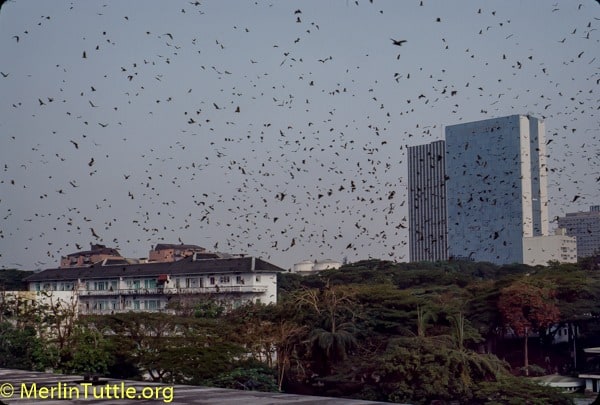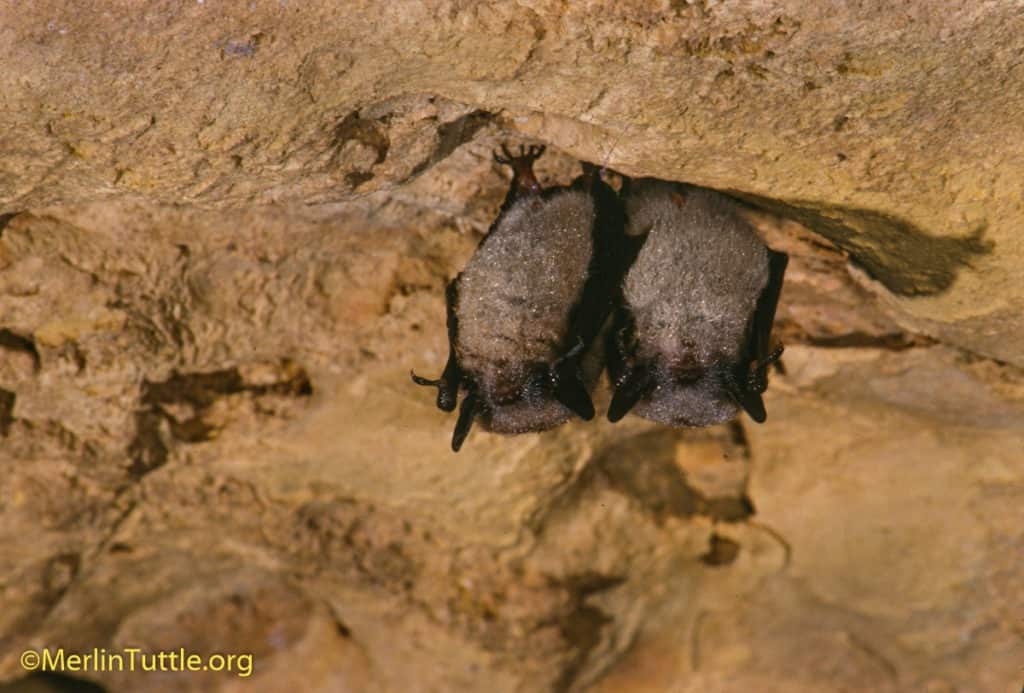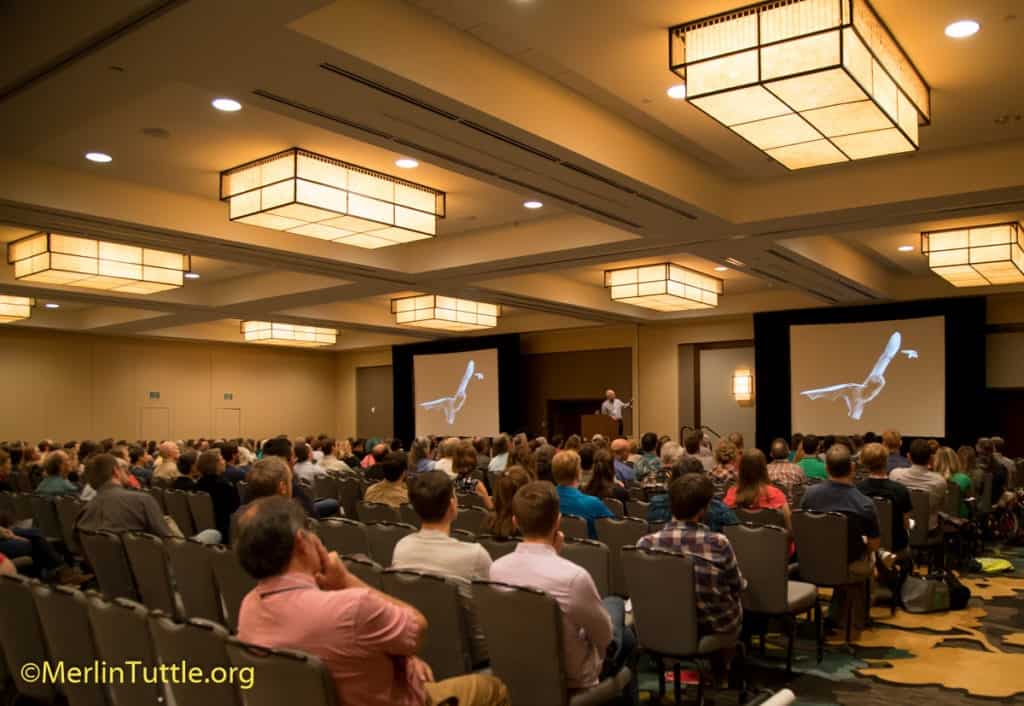The Costs of Bat Decline
Can we afford to lose bats? A recent study by Eyal Frank of the University of Chicago reveals that the dramatic decline in U.S. bat
Merlin provided perspective on bat conservation progress in America over the 46 years since annual meetings of North American bat researchers began in 1970. At that time most Americans had been led to believe that bats were little more than disease carrying, mostly rabid vermin, and frightened citizens were spending tens of millions of dollars annually hiring pest control companies to poison bats in buildings.
Our early research objectives included studies documenting that scare campaigns by those profiting from human fear were themselves posing the most serious threats to public health. We put fear in perspective, showing that bats, in fact, have one of our planet’s finest records of living safely with people, documented numerous values of bats, gradually overcame historic misperceptions and gained protection for thousands of critical bat roosting habitats. As interest and appreciation of bats increased our group grew from 42 to over 400 participants, and we can now take great pride in many accomplishments.
Nevertheless, several alarming reversals are once again posing serious threats to bats and the ecosystems and economies they protect. In North America alone, hundreds of thousands of bats are now being killed annually at carelessly operated wind energy facilities that are rapidly expanding. Unfortunately, too many companies are ignoring recent studies documenting how to dramatically reduce kills at minimal cost. Merlin stressed the importance of partnering with concerned industry officials to rank companies based on their “green” records in avoiding needless harm to bats. He reported willingness of “green energy” advisers to inform investors, noting that through such collaboration, there is still hope for an improved future.

The good news is that small, apparently resistant remnants of even the most seriously threatened species are beginning to show signs of recovery. And given careful protection, there is hope for successful rebuilding of resistant populations, as appears to have already occurred in Europe and Asia. The need for improved use of non-invasive, active-season monitoring of status trends was also stressed.
Merlin’s greatest concern focused on the alarmingly pervasive resurgence of greatly exaggerated speculation about the potential for bats to serve as reservoirs for so-called “emerging diseases.” He emphasized the exceptionally poor science backing these already widely accepted claims. There have been too many attempts to prove rather than test hypotheses, as well as cases of misinterpreting isolated correlations as causation while ignoring large amounts of contradictory evidence. He also showed examples of subsequently discredited speculation, published in leading journals, warning of their potential to reverse decades of conservation progress, not to mention the credibility of science itself. For additional detail regarding this newly emerging threat to bats, visit our Exaggerated Disease Warning Resource Page.

He next emphasized the power of research documenting bat contributions to human well-being and the need to communicate such findings effectively to the public at large. He reminded young colleagues that most of the world’s more than 1,300 bat species have barely been studied beyond being taxonomically described and predicted exceptional opportunities for exciting discoveries. He especially mentioned potential discoveries enhancing pest control, ecoservices, disease prevention and human longevity.
Finally, Merlin provided an example of the economic impact of restoring just one large bat colony in Thailand. Guano production for fertilizer rose from $12,500 in 1981 to $132,000 annually by 2002 and local control of rice pests is now valued at $300,000 annually. He challenged colleagues to become more actively engaged in sharing their findings from human-relevant research beyond their immediate colleagues and offered free use of his large photo collection in support of such efforts.

Love our content? Support us by sharing it!
Can we afford to lose bats? A recent study by Eyal Frank of the University of Chicago reveals that the dramatic decline in U.S. bat
Bats are among the most fascinating yet misunderstood creatures in the natural world, and for many conservationists, a single experience can ignite a lifelong passion
Many bat conservationists know that Kasanka National Park in Zambia is an exceptional place for bats, but it is also the place that sparked my
The Kasanka Trust is a non-profit charitable institution, which secures the future of biodiversity in Kasanka National Park in Zambia. They welcome internships for students
2024 © Merlin Tuttle’s Bat Conservation. All rights reserved.
Madelline Mathis has a degree in environmental studies from Rollins College and a passion for wildlife conservation. She is an outstanding nature photographer who has worked extensively with Merlin and other MTBC staff studying and photographing bats in Mozambique, Cuba, Costa Rica, and Texas. Following college graduation, she was employed as an environmental specialist for the Florida Department of Environmental Protection. She subsequently founded the Florida chapter of the International DarkSky Association and currently serves on the board of DarkSky Texas. She also serves on the board of Houston Wilderness and was appointed to the Austin Water Resource Community Planning Task Force.
Michael Lazari Karapetian has over twenty years of investment management experience. He has a degree in business management, is a certified NBA agent, and gained early experience as a money manager for the Bank of America where he established model portfolios for high-net-worth clients. In 2003 he founded Lazari Capital Management, Inc. and Lazari Asset Management, Inc. He is President and CIO of both and manages over a half a billion in assets. In his personal time he champions philanthropic causes. He serves on the board of Moravian College and has a strong affinity for wildlife, both funding and volunteering on behalf of endangered species.